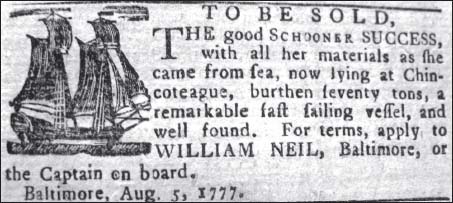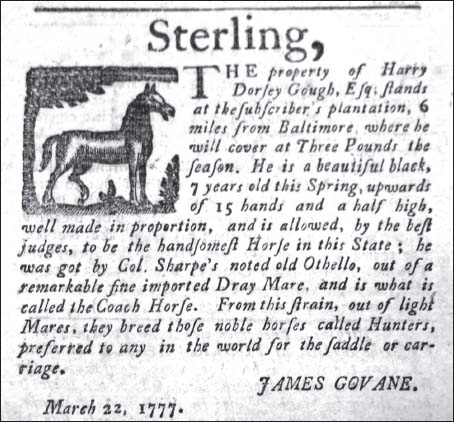

Mary Katherine Goddard spread the news of the event that sparked the American Revolution.
Baltimore: April 26. We have just received the following important Intelligence…. Be it known that this morning, before Break of Day, a Brigade, consisting of about 1000 or 1200 men, landed at Phip’s Farm, at Cambridge, and marched to Lexington, where they found a Company of our Colony Militia in Arms, upon whom they fired, without any Provocation, and killed 6 men, and wounded 4 others…. Printed by Mary K. Goddard.
Mary Katherine was the publisher of Baltimore’s Maryland Journal, the first and only newspaper in that city. Her brother, William, had started the paper and was the owner. News of every sort filled the Maryland Journal:

Courtesy of the John Carter Brown Library at Brown University
Able-bodied freemen from the ages of 17 to 50 could enlist for a three year period. Bounties of twenty dollars and a suit of clothes were used to attrack recruits …
Mrs. Smith, in the 109th year of her age, who lately danced at a wedding, and sung a song of thirteen verses distinctly … she mounts horse with great ability …
SIXTY DOLLARS Reward
Ran away from the subscriber, living near Annapolis, the 20th of May last, a Mulatto Slave named PETER, a likely well made fellow, about 5 feet 8 inches high, and 23 years of age … a great rogue.
At the time of the American Revolution, news was printed on broadsides—long, single sheets of paper, almost like posters. People read broadsides of papers like the Maryland Journal to find out what was happening in that time before radio, TV, telephones, Twitter, or the Internet. Announcements of plays and church sermons printed on broadsides were distributed to subscribers. The Maryland Journal also featured ads.
George Washington of Mt. Vernon in Virginia offers for sale twenty thousand acres of western lands.
Thirty Dollars Reward
Strayed or stolen from Baltimore-Town … white HORSE … he paces, trots, and canters; he has lost one of his eyes …
Wants A Place
A MAN and his WIFE, who are capable of taking charge of a plantation. The Man understands accounts…. The Woman is well acquainted with the management of a dairy.
The lives of Mary Katherine and her brother, William, were intertwined from birth. They were the children of Giles Goddard, a physician and a postmaster in New London, Connecticut, and Sarah Updike, a highly educated woman whose ancestors were among the first settlers of Rhode Island. Sarah tutored the siblings in French, Latin, and the classics.

Masthead of the Maryland Journal.
Library of Congress; photo by Susan Casey

An ad for a schooner for sale that appeared in the Maryland Journal, August 12, 1777.
Library of Congress; photo by Susan Casey

An ad for a horse for sale, Maryland Journal, April 15, 1777.
Library of Congress; photo by Susan Casey
When William left home to be a printer’s apprentice on a newspaper, New Haven’s Connecticut Gazette, it was the start of a series of newspaper ventures that soon involved both Mary Katherine and her mother. After Giles Goddard died, Sarah lent her son the money to set up a printing business in Providence, Rhode Island. When he needed help, Sarah and Mary Katherine joined him at the paper he started there, the Providence Gazette, and the women learned the printing trade. The mother-daughter team took over when William left to work on and start other papers, and the pair published the Providence Gazette from late 1765 to November 1768. Other women in other colonies were also running newspapers.
Sarah and Mary Katherine not only published the newspaper, but also wrote and edited the stories, sold subscriptions, and collected the debts when subscribers didn’t pay. The entrepreneurial pair also printed almanacs, pamphlets, and books, and they opened a bookstore and bindery.
To print pages of the Providence Gazette, Sarah and Mary Katherine put on large aprons, rolled up the sleeves of their dresses, and set the type using printer’s sticks to hold together small pieces of metal that were topped with raised letters that formed words, lines, and paragraphs. The women, like other printers, used leather balls to spread ink on the metal letters. After putting paper over the inked letters, they used a hand press to transfer the ink off the metal onto the paper. They pulled the paper off then let it dry.
Mary Katherine and Sarah might well have continued to publish the Providence Gazette, but William asked them to move to Philadelphia and assist him on a paper he started there, the Philadelphia Chronicle and Universal Advertiser. His mother protested, not wanting to move to a new place at her age of almost 70. But in 1768, both Sarah and Mary Katherine joined him. Sarah died two years later in 1770.
William and Mary Katherine worked on the Philadelphia Chronicle and Universal Advertiser until May 1773, when William moved to Baltimore to start yet another paper, the Maryland Journal. Mary Katherine successfully ran the Philadelphia paper herself but left it when William appealed to her to take over the Maryland Journal.
On February 17, 1774, Mary Katherine informed readers of the Maryland Journal that she would conduct the newspaper and printing business of her brother while he was away establishing a postal system to replace the British one. It was later adopted by the Continental Congress and is today the United States Postal Service. Through the influence of her brother, Mary Katherine then became the postmaster of Baltimore in addition to being the publisher of the Maryland Journal.
The Maryland Journal thrived under her leadership. It was read not only in Maryland but also in other colonies at a time when many other journals had gone out of business. That was no small feat for Mary Katherine. When there was a paper shortage during the Revolution, she managed by printing broadsides on small-sized sheets of paper. When subscribers couldn’t pay, she accepted beef, beeswax, and other foods as payment. To supplement her income, she also ran a book bindery.
Almost a year after taking over the paper, in the issue dated May 10, 1775, Mary Katherine acknowledged her role on the paper to its readers by printing at the bottom of the broadside: “published by M. K. Goddard.” It was only a month after the battle at Lexington and Concord.
Then she took an even bolder step. The first broadside featuring the Declaration of Independence had been printed and distributed by John Dunlap of Philadelphia. The Continental Congress, the ruling body of the colonies, was in Philadelphia and had commissioned it. That printing of the Declaration of Independence didn’t include the names of the signers other than John Hancock and Charles Thompson. Why? The signers were considered traitors by the British and were fearful of British responses. Emotions ran high, and there were some real consequences. For example, when British troops arrived on Long Island in September 1776, they set out to find one of the signers, Francis Lewis, and when they couldn’t find him, they wrecked his home and made his wife, Elizabeth Lewis, a prisoner.
As the war continued and after the British took over Philadelphia, the Continental Congress set up in Baltimore, Maryland, home of the Maryland Journal. Stories in the paper told of the Congress’s arrival and of events of the war that didn’t favor the revolutionary cause. Then at the end of the year, after wins at Trenton and Princeton, New Jersey, the members of the Continental Congress were encouraged. Perhaps the Revolution would be a success. They wanted to reaffirm their stance and ordered a printing of the Declaration of Independence that included the names of all the signers. They turned to Mary Katherine Goddard to publish it in the Maryland Journal.
Mary Katherine didn’t merely print the document on the front page on January 18, 1777, she also applauded it. On the bottom of the document, instead of the usual, “Printed by M. K. Goddard,” she included her full name—“Printed by Mary Katharine Goddard”—boldly acknowledging her personal support for the revolutionary cause. And she included a comment in the paper: “This was by no means the first printing of the Declaration of Independence for there had been at least eight before it, but it was the first official issue with the names of the signers.” (Note: She spelled her name differently on the Declaration than she did normally. At the time people could sometimes spell their names different ways at different times.)
Thirteen years later, in 1789, the year that the US Constitution was adopted, Mary Katherine gave up her position as publisher of the Maryland Journal after a dispute with her brother. She also lost her position as postmaster. New administrators informed her that in the future the job would entail more traveling throughout the southern states than could be expected of a woman. She didn’t agree. She fought to retain her position by appealing to George Washington and Congress. More than 200 Baltimore businessmen enthusiastically endorsed her petition, wary of losing her for someone who might not have been as proficient, to no avail.
Mary Katherine persevered. She retained a printing business and in addition opened a bookstore and ran it until 1802. She died in Baltimore on August 12, 1816. In her will, she freed her slave, Belinda Starlin, and left all of her property to Belinda.
What is her legacy? Mary Katherine Goddard embraced a profession dominated by men and held her own. She succeeded as a newspaperwoman, postmaster, and store owner. And she proclaimed her support for the American Revolution in print. Mary Katherine Goddard deserves a high rank among women of the Revolutionary War.

Early American Women Printers and Publishers, 1639–1820 by Leona Hudak (Scarecrow Press, 1978)
“Mary Katherine Goddard”
Women in the U.S. Postal System
Smithsonian National Postal Museum
http://postalmuseum.si.edu/WomenHistory/women_history/history_goddard.html
“Mary Katherine Goddard (1738–1816)”
Maryland State Archives
http://msa.maryland.gov/megafile/msa/speccol/sc3500/sc3520/002800/002809/html/2809bio.html
“Mary Katherine Goddard (1738–1816)”
National Women’s History Museum
www.nwhm.org/education-resources/biography/biographies/mary-katherine-goddard